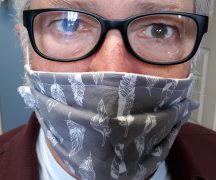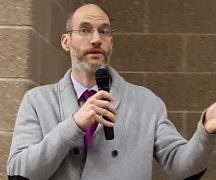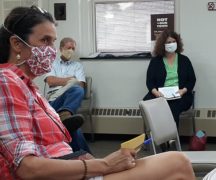By JAN LARSON McLAUGHLIN
BG Independent News
For more than a century now, public health services in Wood County have gone where few others want to tread.
In the early years that meant inspecting overflowing outhouses, vaccinating against highly contagious diseases and dealing with dumps scattered throughout the county.
In recent years that has meant some of the same lingering issues like dealing with foodborne illnesses, looking for faulty septic systems leaking raw sewage into ditches, and enforcing smoking bans.
Now it means offering dental care for those those who have gone untreated for years, and preparing for the Coronavirus.
Last week, the Wood County Health Department celebrated a century of responding to local public health needs.
Wood County Health Commissioner Ben Batey said he attended his first health board meeting as a student to meet a requirement for his master’s degree. The meeting was held at the fairgrounds after a mass vaccination site was set up for the H1N1 flu, giving more than 2,000 immunizations.
“That was public health,” Batey said.
When he later joined the Wood County Health Department as an infectious disease nurse and emergency response coordinator, Batey got a quick baptism in public health. On his second day, former environmental health director Brad Espen asked him to help cut off the head of a raccoon to be tested for rabies.
“I think I passed that test,” Batey said. “That’s public health.”
Days later, a tornado hit Lake Township, killing seven and destroying the high school and many homes. Health department staff responded, offering tetanus shots to those cleaning up debris.
“That’s public health,” Batey said. “We go where we’re needed, when we’re needed.”
The work is constant, keeping up with standard services like inspections of restaurants, tattoo parlors, swimming pools, manufactured home parks and septic systems, and making sure lower income children have adequate nutrition, and have services for medical handicaps.
And the work is varied, dealing with new illnesses such as SARS, Ebola, Zika virus and Coronavirus.
“We stay up late at night, worrying about them,” Batey said. “That’s public health. We are the guardians who work behind the scenes so everyone else can rest easy.”
Black and white photos and old newspaper clippings showed the impetus for public health, and the continuing challenges it faces. The Spanish flu and smallpox epidemics in 1917 and 1918 are believed to be the push behind public health programs nationally.
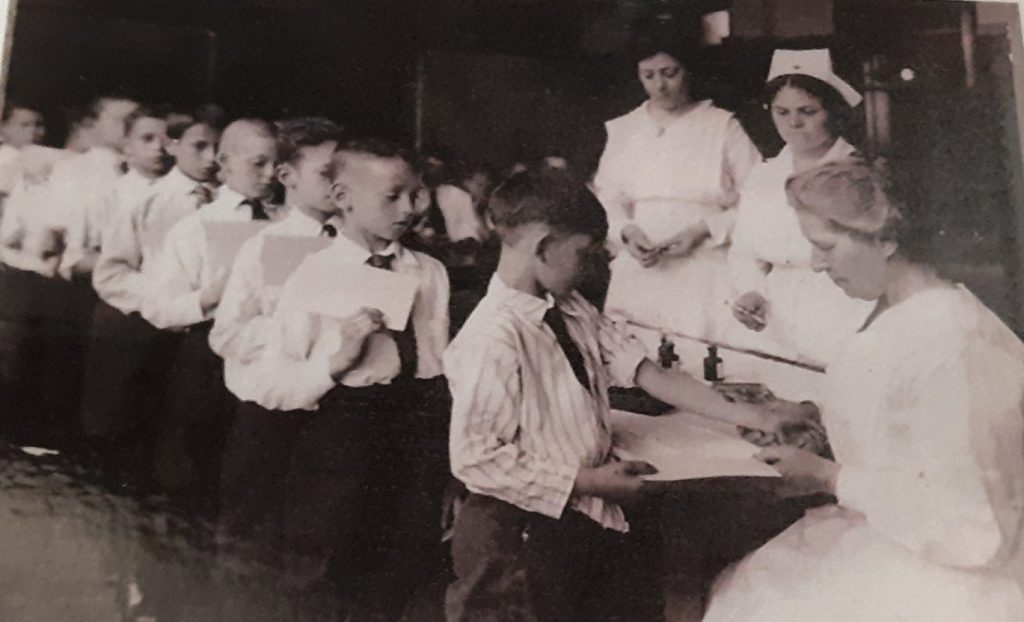
Photos showed lines of children with rolled up sleeves getting vaccines, and rows of cots set up in makeshift hospitals filled with people sickened by the Spanish flu and smallpox.
The early promotional items put out by public health mixed humor and scare tactics. One showed an outhouse, warning that “Sanitary privies are cheaper than coffins.” Another from 1952, offered safety tips to avoid polio such as avoiding mixing with new groups.
When microwave ovens started entering everyday kitchens, a newspaper story told of the health department offering testing for local residents skeptical of the new technology. Of the 212 microwaves tested, 28 were found to have “measurable radiation leaks.”
Another clipping told of the health department identifying nearly 150 people who became sickened after eating at a threshing festival. And another of the health department responding after Bowling Green residents and businesses complained of increased pigeon droppings.
Later stories told of the health department working to find a suitable site to take 55 tons of used tires, enforcing smoking bans, inspecting homes for lead poisoning, and leading the effort to bulldoze dilapidated structures in the county.
And now there are stories of some historical issues returning to the forefront – measles among those opposed to immunizations, and vaping replacing cigarettes as a health concern.

Offering a historical perspective at the century celebration was Ned Baker, who served as a sanitarian at the Wood County Health Department from 1950 to 1955. He went on to work for the Ohio Department of Health, serve on the local board of health, and establish the National Association of Local Boards of Health.
Baker was lured into public health after getting a biology degree after World War II.
“I knew I didn’t want to spend all my time in a laboratory, but I didn’t know there were any other options,” he said.
Then he found public health, where he used his education to inspect local dairies to ensure milk sanitation, and local restaurants to ensure safe handling of food.
Offering some future predictions for public health was Dr. Phil Welch, who teaches public health at Bowling Green State University. The work will be impacted by the lengthening lifespans of humans and mainstream use of technology like driverless cars.
“Public health soldiers” with continue to shift focus to meet new needs, Welch said.
“In public health, we’re all about people,” he said. “We’re all crusading for the prevention of disease. We can all do that by being passionate about public health.”
The Wood County Commissioners praised the local health department for meeting those changing needs – specifically for establishing a dental clinic for people not served by private practices.
“We are recognized for the wonderful work of the Wood County Health Department,” Commissioner Doris Herringshaw said.
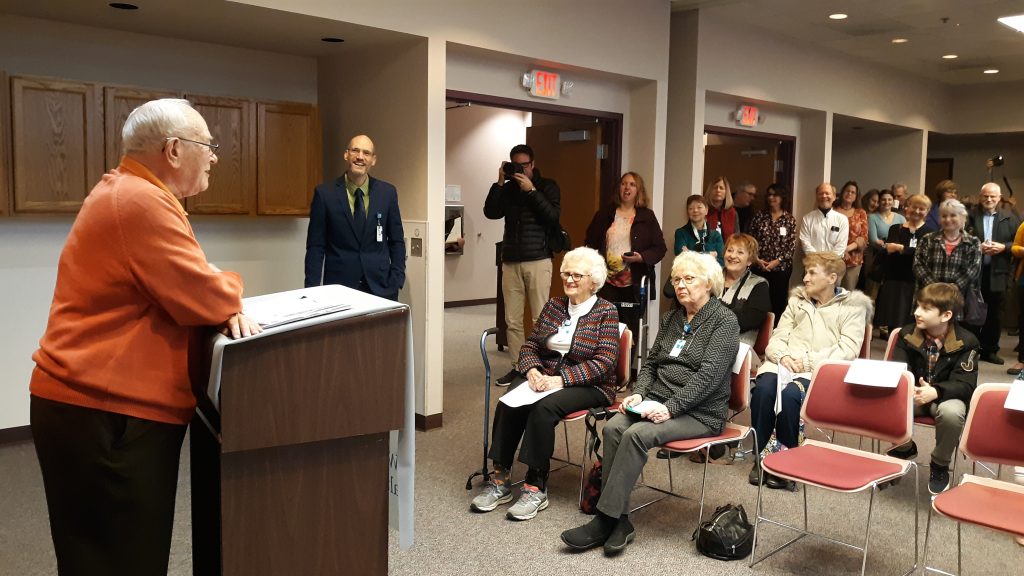
The health department recognized Baker with a “Public Health Champion Award,” for providing a “unified voice in public health across the nation.”
Also recognized were long-time health board members Betty Woods, from Rossford, and Carolyn Rava, from Perrysburg. Woods, who has served 24 years, and Rava, who has served 21 years, have helped shape the Wood County Health Department, Batey said.
Following are some highlights of public health in the past century:
- 1917 – Ohio began experiencing an epidemic of smallpox, with more than 11,000 cases reported.
- 1918 – An outbreak of Spanish flu spread through Europe to the U.S. Businesses and schools closed during the height of the pandemic, which was estimated to have killed 50 million people worldwide, including 670,000 Americans.
- 1920 – Wood County created a health district, which sought to control infectious diseases by allowing people who were ill to be excluded from schools, theaters, movies, billiard halls and churches. Regulations allowed the inspection of schools, slaughterhouses, dairies, bakeries, restaurants, meat and milk producers, green grocers and ice suppliers. Nuisances like manure removal, unsuitable housing and disposal of sewage, soap suds, liquid manure and hogs were also addressed.
- 1921 – Wood County saw 506 reported cases of contagious diseases, with diptheria accounting for more than 20%.
- 1922 – A rabid dog in Rossford bit eight people. The health commissioner ordered that all dogs in the city be quarantined and all strays picked up. The eight victims received treatment at the expense of the health department.
- 1923 – Board of health minutes recorded that “very unscrupulous persons were peddling meats in the streets of some of the villages without much attention to sanitary conditions.”
- 1927 – The health department’s budget included money to help people who could not afford the cost of minor surgery or eye glasses.
- 1934 – A regulation was passed requiring landlords to remove outside toilet facilities and clean up the remaining sewage in areas within 30 feet of wells that provided drinking water for nearby residences.
- 1940s – Libbey Owens Ford requested an X-ray screening program, and as a result, 4,500 people were screened for TB. This was the first indication of an occupational health program in health board minutes.
- 1946 – Mass X-ray screening of school children found 13 suspicious cases of tuberculosis and 17 children with cardiac defects, tumors and other health problems.
- 1948 – The health department had concerns about sanitation at Bowling Green swimming pool and local dumps. Milk quality remained one of the most pressing public health issues.
- 1949 – Wood County’s sanitarians set the goal of inspecting restaurants four to six times a year.
- 1950s – Issues included people in Tontogany who were carrying water from a contaminated well, sanitary conditions at some schools, outdoor toilets, garbage and rats, trailer camps, sewage installations, water sampling, trichinosis from bologna made at a local slaughterhouse, milk plants, swimming pools and rest homes. There were still “privies” overflowing in Bowling Green and Rossford.
- 1959 – Ohio began requiring certain immunizations to attend school.
- 1963 – The local health department decided health education efforts should focus on smallpox vaccinations, venereal disease education in high schools, and eliminating tuberculosis. A new sanitarian was directed to search for homes discharging raw sewage into streams and ditches.
- 1985 – There was an epidemic of Norwalk-like viral gastroenteritis at BGSU. The incident received national coverage.
- 1995 – The board of health approved new regulations for tattoo establishments.
- 1995 – A wastewater dye mishap in Fostoria caused the Portage River to turn fluorescent green – but no health concerns were found.
- 1996 – HIV prevention curriculum and videos were developed for all Wood County schools.
- 2001 – Terrorists attack the World Trade Center and Pentagon. Anthrax found in mail on the East Coast leads to an increase in the number of suspicious letters reported to law enforcement around the country. Locally, emergency responders and health department staff responded to numerous reports of suspicious letters, none of which tested positive for anthrax.
- 2006 – The health department investigates multiple cases of MRSA in athletes.
- 2009 – The first H1N1 flu case was reported in Wood County. The health department held 18 vaccination clinics in three months and gave thousands of vaccines.
- 2010 – Lake Township was hit by a tornado that killed seven people and destroyed homes and Lake High School. Health department employees helped with the response and administered tetanus vaccines to volunteers cleaning up debris.
- 2014 – Microcystis toxin was found in Toledo metropolitan water supply. The three-day ban on drinking or using tap water affected more than 400,000 people, including many in Wood County.



